Hamlet, William, the Elder (McKechnie Section 3)
See also Section Two
Until recent years it was believed that there was only one silhouette artist named William Hamlet. Research carried out since the Second World War, however, has established that there were two artists of this name, probably father and son, and I have therefore devoted separate entries to William Hamlet the elder and (also in this Section) to William Hamlet the younger. The elder Hamlet seems to have been responsible for the better examples of the work hitherto collectively ascribed to 'William Hamlet'. The younger artist, on the other hand, was probably responsible for the silhouettes in colour (on card or ivory), as well as for the en grisaille pieces, since work of this type is not mentioned on any of the trade labels used by the elder Hamlet after 1800.
The first known reference to the work of William Hamlet the elder in this country occurs in an issue of Jackson's Oxford Journal (18 June 1785; repeated on 16 July):
Striking Likenesses in one Minute at 2s. 6d. each, and shaded 3s. Stained on glass for 5s., and in Full-Length for 10s. 6d. by William Hamlet; From Abroad, at Mr. Archer's, Gilder, in the High-Street, who has now formed a Methodical Model of Amusement for Ladies and Gentlemen, which will go into a Pocket Book, and will take two Striking Likenesses in One Minute only. Any Person taking a copy of his own or another's Likeness to any number in a Few Minutes without the least Difficulty. He begs Leave to recommend the same to the Notice of the Ladies and Gentlemen of this University and City, as they may be assured, they will by this portable Model enabled to supply their distant Friends at any time with an exact Likeness, without any additional Trouble or Expence:— the Price of the Model is Five Shillings.
Likewise his curious new invented Profile Reflector, by which an Likeness may be taken in the strongest Manner, and more perfect than by any other Reflection or Shadow whatever. It has already met with the Approbation of many Noble Personages, &c., at Bath, where it was lately for the first Time exhibited by the Inventor: ⎯ Also about 400 other Drawings among which are the Likenesses of many of the Nobility of France, Ireland, Great Britain, &c.
Hamlet returns his Thanks to the Nobility, Gentry and the Gentlemen of the University, for their kind Encouragement:— His Stay will be short here.
The phrase 'from abroad' suggests that Hamlet was of foreign extraction. (Most British artists who had simply visited a foreign country would have used the expression 'having lately returned from . . . ' in such an advertisement.) One might infer from the list of places in which Hamlet states that he had worked that he had begun his career in France, then visited Ireland, and later settled in Great Britain. It seems possible, therefore, that Hamlet was of French origin. At the Bibliothèque Nationale, Paris, there is a record of the existence during the nineteenth century of a family of painters named Hamlet-Griffiths. Three brothers of this name are known to have exhibited at societies of art in France 1861-78. This family (whose members lived at Creil in the Département of L'Oise and Beauvais north of Paris) may have been distantly connected with the Hamlets who had worked in England (mainly in Bath) at an earlier date.
In the entry on W. L. Holland in this Section I mention that this Dublin artist used a device for painting profiles on glass, 'being the invention of a foreign gentleman who has brought this art to a perfection never before known in this country'. As it appears from the Oxford advertisement that Hamlet had visited Ireland before settling in England, he may well have sold to Holland one of the two types of mechanical device mentioned in bis advertisement.
It is also clear from the advertisement that Hamlet had visited Bath; possibly he made this city his first centre in England, probably from about April 1785, although no silhouette by Hamlet bearing such a date is known and no advertisement by Hamlet appeared in issues of Bath newspapers of that period of which copies survive. Hamlet cannot yet have been working in Union Passage or Union Street, Bath (both associated with his name), for the former was not given its first lease until 1789 and the latter not until 1806. One silhouette which dates from the artist's visit to Oxford in 1785 is illustrated.
Later in the same year Hamlet visited Birmingham, where he advertised in Aris' Birmingham, Gazette in September. This advertisement tells us that Hamlet was now exhibiting a thousand 'drawings', not the mere four hundred exhibited in Oxford. The text is as follows:
STRIKING LIKENESSES
Taken in One Minute at 2s. 6d. each, shaded and coloured to 5s., and in full-length for 10s. 6d. by
WILLIAM HAMLET, from Abroad. (being the most singular artist in this Kingdom) at Mr. Crane's, No. 6, Opposite the Shambles, High Street, Birmingham, who has invented a Methodical MODEL of AMUSEMENT for Ladies and Gentlemen, which will go into a Pocket-Book, and will take two striking Likenesses in one Minute only. Any Person may take off his own or another's Likeness, to any Number, in a few Minutes, without the least Difficulty. He begs leave to recommend the same to the Notice of the Ladies and Gentlemen of this Town, as they may be assured, they will by this portable Method be enabled to supply their distant friends at any Time with an exact Likeness, without any additional Trouble or Expence — the price of the Model is Five Shillings.
Likewise, his curious new-invented PROFILE REFLECTOR, never seen here before, by which any Likeness may be taken in the Strongest Manner. It has already met with the Approbation of many noble Personages, &c., at Bath, and at the University of Oxford, where it was lately, for the first time, exhibited by the Inventor.
Also, a striking Likeness of Mr. Sadler, and about 1000 other Drawings, among which are the Likenesses of many of the Nobility of France, Ireland, Great Britain, &c.
'Mr Sadler' was James Sadler, the first English-born aeronaut, who made his ascent, the second in England. from Oxford on 4 October 1784. His portrait, engraved by Thornton, appeared in the New London Magazine in 1785. Hamlet may have taken his silhouette from this; although, since Sadler was an Oxford man, Hamlet may have taken the silhouette from life .
Though this advertisement mentions coloured work, no coloured silhouette by Hamlet, dating from 1785, appears to have come to light.
No silhouette which is attributable to Hamlet, and which appears to date from the period 1785-c. 1805, is known. During these twenty years the artist may have returned to France (if indeed it was from this country that he hailed), or he may have remained in England and taken up some other trade.
Hamlet did resume working in Bath at some date after 1800, but we do not know when. The younger Hamlet appears to have worked at 9 Union Passage c. 1804-1805. Since a silhouette of about this date, inscribed 'By W. Hamlet, Junr', has been seen, presumably the elder artist was once again working in the city by then; otherwise, the younger artist would not have added the word 'Junr.' to his inscription. Hamlet the younger was certainly working at 2 Old Bond Street, Bath, by May 1815, and possibly earlier. If the entries (given below) in directories and guides were up-to-date, it appears that Hamlet the elder remained at 12 Union Street until 1816; the directory entry for this year which probably refers to him (not to the younger Hamlet) provides the last evidence of his life and work in Bath.
Rate books are of little assistance as far as Hamlet is concerned. Those for Bath Abbey (in which parish 17 Union Passage, an address often given on silhouettes by Hamlet, was included) are incomplete for the early 1800s; but entries in rate books for the period 21 February 1805 to 23 January 1806 list a Mrs Phillott at this address. She paid a rate of 14 shillings a year for the premises at 17 Union Passage, which appears to have been divided into three tenements. Phillott was a well-known name in Bath; a Charles Phillott, for instance, served as alderman during 1797, 1805 and 1814, and a Joseph Phillott was alderman during 1811. We can assume, from their trade labels, that both Hamlets presumably rented a tenement from Mrs Phillott. (The house was demolished c. 1966.)
Directory references yield a little information about Hamlet. Although they give the name without any initial, entries dating from before 1815 probably refer to both artists; entries for 1815-16, to the elder Hamlet. The following list is taken from lists of artists in contemporary Bath guides and directories:
1812 Hamlet, Profile-Painter, 12 Union Street [directory]
Hamlett, Profile-Painter [list of artists in the same directory]
1813 Hamlet, Profile-Painter, Union Street (Bath Guide]
1815 Hamlett, Profile-Painter, 12 Union Street
1816 Hamlet, 12, Union St. Profile-Painter.
1819 Hamlett, Mrs., 26 Rivers Street [probably the widow of William Hamlet the younger]
The earliest recorded dated profile dated after 1800 which shows Hamlet's hand seems to be that of S. A. R. Le Comte de Beaujolais, brother of Louis-Philippe and son of Égalité d'Orleans. This piece (illustrated by Mills) is inscribed on the back 'done for the Parry family, 1807'. It is possible that this profile was based on an original taken from life in France. Mr Graham Thomas has seen a silhouette, on card, of a Mr Thomas Boys, dated March 1807. This bore Trade Label No. 3. Mr H. P. Crallan owns a silhouette, taken by Hamlet, of an ancestor, John Crallan, who was drowned off Newfoundland on 25 August 1811; this bears Trade Label No. 4, with the address 12 Union Street. The sitter, a boy of fourteen, is shown wearing a jacket with gold buttons. This silhouette must have been taken by June 1811, indicating that the Hamlet studio was established at this address by this date. A profile in the Victoria and Albert Museum, London, of a Miss Elizabeth Tydell, probably by Hamlet the younger, dated 1810, shows Hamlet the elder's Trade Label No. 3, which suggests that the move to Union Street (the address given on this label) occurred either late in 1810, or early in 1811. Both Hamlets used the same trade labels (those of the eider Hamlet) until 1815.
Hamlet's three printed trade labels (used c. 1805-c. 1816) are headed by the Royal coat-of-arms and by the phrase Patronised by Her Majesty'. Indeed, perhaps his silhouette of Queen Charlotte is his best known; it is perpetuated on some of the Coalport porcelain made to celebrate George III's Jubilee. Hamlet took a number of Royal portraits, most of them in Weymouth, which he probably visited more than once during 1806 and 1807. Some of these Royal portraits are inscribed with the address '2 Conyger Street'; though this street is unknown today, an old map of Weymouth records that the present Bond Street was at one time known as Conygar Ditch, and it was possibly here that Hamlet stayed. Hamlet may have taken his silhouette of Queen Charlotte in Weymouth from life, and copies may later have been sold in Bath. There is no proof that any of Hamlet's numerous silhouettes of George III were taken from life; he may have copied them from copies (on sale in Bath) made by Charles Rosenberg from silhouettes which he had painted from life.
A crude full-length profile of George III by Hamlet, bearing on the reverse the inscription 'By W. Hamlet of Bath and Salisbury', has been seen. Since it was probably a 'repeat', it is difficult to deduce from it when Hamlet visited Salisbury. There is no evidence that Hamlet ever worked in London.
Probably the death of the younger Hamlet in November 1815 caused the elder Hamlet to abandon silhouette work.
On 19 June 1917 a number of silhouettes from the Wellesley collection labelled with the name Hamlet (presumably the elder but possibly the younger) were sold by Christie, Manson and Woods, London. I list them below (with details of the complete lots, since only a few of these silhouettes were sold singly and the prices given for the lots are of interest).
Lot 33 The Duke of Cambridge, by Hamlet, John Smyth by the same; the Duke of Grafton, by Rosenberg, and a gentleman, by Rider and Bazing. 10 guineas.
Lot 67 The Rt Hon. William Pitt, by Hamlet [attributed by Mills to Mrs Barren], Le Comte de Beaujolais, and four others by Hamlet. 32 guineas.
Lot 70 The Duke and Duchess of Gordon, by Hamlet, and four others by 'H. P. Roberts'. [These four are now known to have been painted by W. J. Jolliffe]. 15 guineas.
Lot 73 Two ladies, by Hamlet, and seven others by Gibbs and Pelham. 6 guineas.
Lot 91 A family group, by Hamlet, on glass; and two others by Rought. 11½ guineas.
Lot 95 A Gentleman, by Hamlet, and eight male portraits, painted between 1838-1841, framed together. 3 guineas.
Lot 118 A family group, by Hamlet on glass 10½ x 13¾ in. 5 guineas.
Lot 131 The Dukes of Sussex, Gloucester and Cumberland, in oval wood frames, and the Princesses Mary and Sophia, by Hamlet on glass, in square frames. 3½ guineas.
Two other artists named Hamlet, who may have been connected with the two silhouette artists of this name, should be noted here. Long and other authorities record a silhouette artist named T. Hamlet who appears, however, to have been a sculptor. Rupert Gunnis (Dictionary of British Sculptors, London, 1953) records a small bust of the Duke of Sussex, signed T. Hamlet and dated 1826, at Ombersley Court, Worcestershire. He has since told me of two other small busts, of George IV and the Duke of Cumberland (the latter in the Hove Museum), bearing the same signature. I myself have seen, in a private collection, a bust of the Duke of York signed 'T. Haml't of Bath'. T. Hamlet may have been a younger son of William Hamlet the elder.
It is possible that a descendant of the Hamlets is referred to in some letters by D. G. Rossetti. The letters in question (in ms) date from 3 December 1869 until 24 October 1881, and were listed by Maggs of London ('Collection of Autograph Letters of Dante Gabriel Rossetti') in a catalogue (No. 449, 1924). The relevant excerpts follow:
I am greatly interested in young Allan, and should be greatly pleased at the sight of some more cuttings. I wonder if he cottons to Hamlet.
I shall be very pleased to get the Hamlet series. The young artist's hand is as firm and dashing in calligraphy as in silhouette.
I have looked . . . with several friends at the Hamlet silhouettes, and all are lost in wonder at their unique and admirable qualities.
These passages must refer to a silhouette artist named Hamlet who was working in the second half of the nineteenth century. Whether he was descended from the William Hamlets, or from the Hamlet-Griffiths family of Creil, has not been established.
In the Holborne of Menstrie Museum, Bath, there is a folio of genre cuttings, marked the 'Hamlet portfolio', which may contain this artist's work. The cuttings are on black shiny paper, and bear on the reverse a drawing surface on which the cuttings of figures and trees, with romantic backgrounds, had first been drawn before the images were cut out. It may have been work of this type to which Rossetti was referring, and it is possible that the cuttings were made by a grandson of William Hamlet the eider. (This folio also held two life-size profile heads, in duplicate, one of which is marked 'Hamlet's shade of dear F'. Below, a curator has added the words 'Miss Holbourne's writing'. These pieces were presumably basic outlines of the illustrated profile by William Hamlet the eider of Captain Francis Holbourne, who was killed at Bayonne in 1814).
It is possible, but unlikely, that the wealthy jeweller, T. Hamlet, who was responsible for building the Princess Theatre (1840-1900), Oxford Street, London, was connected with the William Hamlets. This Hamlet, whose shop was at the corner of Sidney's Alley, Leicester Square, lost large sums as a result of granting bonds to the Prince Regent and the Duke of York during the 1820s. In 1843 he became bankrupt and he died in 1853, aged eighty-four. He is of interest to historians of English art-collecting as the owner (in 1816) of Titian's Bacchus and Ariadne. For further details see William Twintley, Art in England 1800-1820 (Cambridge, 1928), and E. M. Butler, ed.,4 Regency Visitor: the Letters of Prince Pückler Muskaù 1826-28 (London, 1957).
Bust-length Silhouettes
In his bust-length work on glass, the eider Hamlet achieved a much more consistently high standard' than did the younger Hamlet. He painted on the under surface of convex glass, often backed with a plaster slab on which the shadow of the silhouette is thrown. He used rather small glasses, sometimes measuring only 2½ x 2 in., which is certainly small for a wide profile such as that (illustrated) of George III.
Hamlet rendered his sitters' hair either entirely with a needle, or partly with brushwork, using thinned pigment, rendering locks of hair near the face with the needle (much in the way that he used strokes of Chinese white on card profiles painted on card). He always used a needle to show the outlines of clothing. He rendered transparency on the thin dresses of his women sitters with extreme delicacy, resorting to fine hatching only where this was necessary to show the outline. He used black pigment, quite as deep as that used by Jorden or Rosenberg.
Some of Hamlet's bust-length portraits (especially those of military subjects) are well touched with gold; Mrs Peggy Hickman illustrates one in Silhouettes. Another example (illustrated by me) is the silhouette of General Romana which was probably based on a stipple engraving by Anthony Cardon (1772-1815), which is illustrated in Christopher Hibbert's Corunna (London, 1961). This was probably painted, as a stock silhouette, 1810-11.
Most of Hamlet's bust-line terminations are of the convexity/concavity type, but occasionally he used a flatter line, or a single arc. Hamlet normally used papier mâché frames; one example (1785) is housed in an oval hammered brass frame.
Full-length Silhouettes
Hamlet's full-length work is in general of fine quality — finer than Rosenberg's work, which he sometimes copied.
Hamlet painted his full-length profiles on thin glass, which gives a metallic ring when lightly tapped. He used fine fingerprinting when painting men's breeches and women's dresses, and used the needle to show highlighting or the outline of clothing. Hands and feet are better proportioned in his work than in that of the younger Hamlet, though the heads are sometimes too small.
A table set with inkstands and books is a recurrent formula in the seated portraits; in one there is a large Regency sofa which dwarfs the sitter. Hamlet also used the looped curtain' convention. Most of the standing figures are set on a wash base, shown without fingerprinting. Hamlet was at his best with standing military subjects, some of which are touched with silver as well as with gold; he evidently took especial care with the proportions of these. Hamlet painted both equestrian and standing figures of George III. I have illustrated a standing figure of the King. An equestrian portrait is illustrated by Mayne in 'The Bazing Myth', Antique Collector, April 1969, and I have seen a similar example. Again, both showed finer work than did the silhouettes by Rosenberg on which they were probably based.
1067
Hamlet's full-length silhouettes were normally housed in giltwood frames with acanthus leaf and beading decoration. Sometimes a frame of stained black wood, with ormolu surround, of the type used by William Wellings, was used.
Trade Labels
Hamlet's trade labels present special problems. A Number of silhouette have been seen (some by Hamlet the elder, others by Hamlet the younger) which were taken at different periods but which all bear handwritten trade labels or inscriptions from the hand of Hamlet the elder.
1071-1073
Possibly Hamlet the elder inscribed quantities of these labels for later use either by himself or by his son or relative. All these handwritten labels, some of which were used in Weymouth, may be grouped as variants of Trade Label No. 1. (Silhouettes by the younger Hamlet dating from 1805-15 bear the elder artist's trade labels.)
No. 1a (on which the elder Hamlet's handwriting is identifiable) is on the reverse of the illustrated profile of Mr Trening (?), or Mr Irving, of Trinity College, Oxford, taken in 1785; it reads simply, 'Wm. Hamlett.'
No. 1b is on a crude profile (possibly c. 1806) of George III, painted in full-length on glass and possibly based on a Weymouth scene, since it shows what purports to be the Royal barge: `By W. Hamlet /of Bath & Salisbury'.
No. lc is on the back of a profile of Princess Mary, formerly in the Wellesley collection but now in private possession in Devizes:
Hamlet
Profile-Painter
to Her
Majesty
and the Royal Family
Weymouth,
& No. 17, Union Passage
Bath.
This may date from c. 1806-1807. Another label, on the reverse of a profile of the Duke of Cumberland, in the same ownership, has the same wording, except that 'Ye' is written in place of 'the' in the reference to the Royal Family. These two Royal profiles, together with those of Princess Augusta and the Duke of Cumberland (now in the same ownership), were sold from the Wellesley collection in 1917. The two last named profiles bore Trade Label No. 3 (see below).
No. 1d is on a poor profile miniature in colour (perhaps c. 1810-11; illustrated in Section Six) by Hamlet the younger:
1533
Hamlet
Miniature & Profile
Painter
to Her Majesty
12, Union Street,
Bath
It is also on a privately owned profile of a woman illustrated in Section Two.
822
No. 1e (illustrated) is on the reverse of a profile of Prince Adolphus Frederick, Duke of Cambridge, in the Royal collection.
Of the artist's three known printed trade labels, one (Trade Label No. 2; illustrated) was printed in number of silhouettes have been seen (some by letterpress by Hazard and Binns, and two (Nos 3 and 4) were engraved by Huntley. All show the coat-of-arms of Queen Charlotte, but No. 2 also shows the lilies of France in the second quarter, which were removed by an Order in Council dated 5 November 1800. Since this label appears to have been used at 17 Union Passage c. 1805-1807, the printer's information was evidently out of date.
Trade Labels Nos 3 and 4 are more imposing than No. 2. They differ in their addresses, both in Bath: No. 3 (illustrated; probably used 1807-c. 1810) gives 17 Union Passage; No. 4 (used c. 1810-1816), 12 Union Street. On both labels, Huntley's signature is visible below the Royal coat-of-arms (shown parti per pale).
I should like to add a note about the printers of these labels. I have seen the name Hazard in several old issues of the Bath Chronicle. Hazard was a book-seller in Bath at least as early as 1780, for his name appears in such contexts as subscribers' lists for various charities, and there is a note in the Bath Chronicle of 27 January 1780 that he was paid a sum for printing concert tickets for a Paupers' Charity Concert. At this time he had an address in Kingsmead Square. Printing and bookselling, however, were apparently not his only activities: in an issue of the Bath Herald and Advertiser during 1792 appeared the following announcement:
S. HAZARD, BOOKSELLER, IN BATH,
RESPECTFULLY informs the PUBLIC, he has received another large Box of Mr. SPILSBURY'S Patent Antiscorbutic Drops, of Soho-Square, London, in the new-moulded Boules of Five Shillings each, on which are blown the Words, 'By the King's Patent,' with folio sheet bills of Directions, and near Sixty cures therein; to which he can add his humble testimony of the quick salutary effects of this celebrated Medicine, experienced in cases of the Scurvy, Rheumatism, Gout, Indigestion, and other Irritating vexatious Complaints, for which this Preparation is administered with unparallelled Success.
Hazard's partnership with Binns was not formed until after 1800.
Huntley was John Lockyer Huntley, an engraver to whom land on Bathwick Hill, Bath, was 'granted or intended to be granted' according to deeds (which I have seen) dated 21 December 1810.
Ills. 129, 1057-1073, 1218. 1230
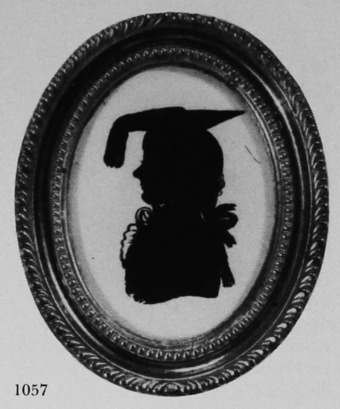
Mr Trening(?) or Mr Irving of Trinity College, Oxford
Silhouette painted on flat glass
1785
3¾ x 3in./96 x 77mm.
Trade Label No. 1a
Frame: oval, hammered brass
The work on this silhouette is primitive.
G. and E. Robinson collection
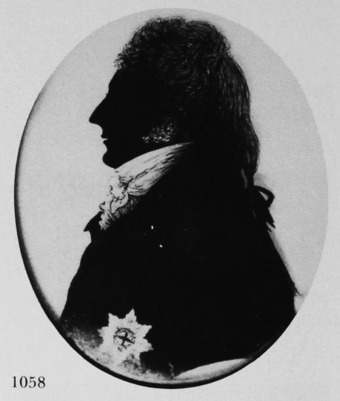
Prince Adolphus Frederick, Duke of Cambridge
Silhouette painted on convex glass
c. 1806-1807
2½ x 2in./64 x 51mm.
Trade Label No. 1e
Frame: papier mâché
The Prince, the tenth child and seventh son of George III, was created Duke of Cambridge in 1801
By gracious permission of Her Majesty the Queen
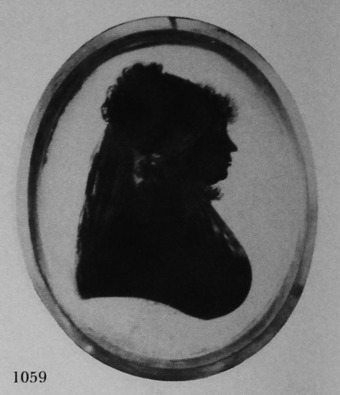
Queen Charlotte
Silhouette painted on convex glass, backed with plaster
c. 1806-1807
2½ x 2in./64 x 51mm.
Trade Label No. 2
Frame: papier mâché
This silhouette was probably painted from life in Weymouth, and copies were probably made later for sale in Bath.
Author’s collection
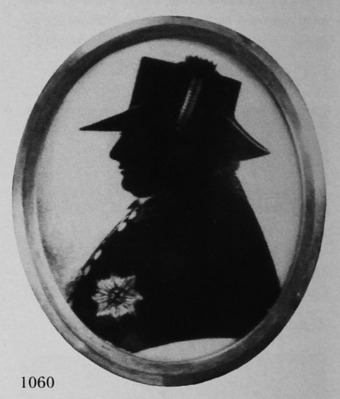
George III
Silhouette painted on convex glass, backed with plaster
c. 1806-1807
2½ x 2in./64 x 51mm.
Trade Label No. 2
Frame: papier mâché
Possibly a copy of an original silhouette (c. 1800) by Charles Rosenberg.
Author’s collection
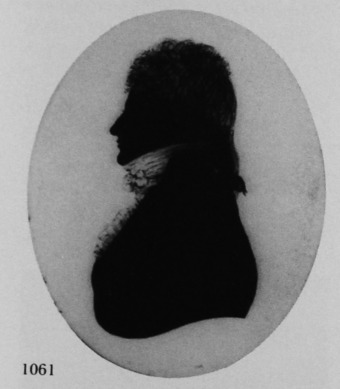
Unknown man
Silhouette painted on convex glass, backed with plaster
c. 1807
2½ x 2in./64 x 51mm.
Trade Label No. 3
Frame: papier mâché
Author’s collection
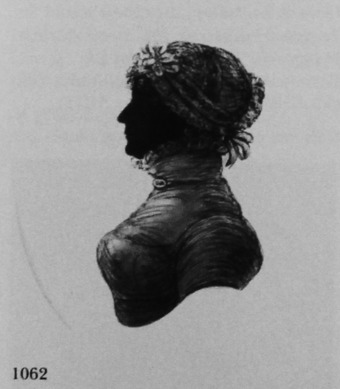
Unknown man
Silhouette painted on convex glass, backed with plaster
c. 1808
2¾ x 2¼in./70 x 58mm.
Frame: papier mâché
Probably taken at 17 Union Passage, Bath.
M. A. H. Christie collection
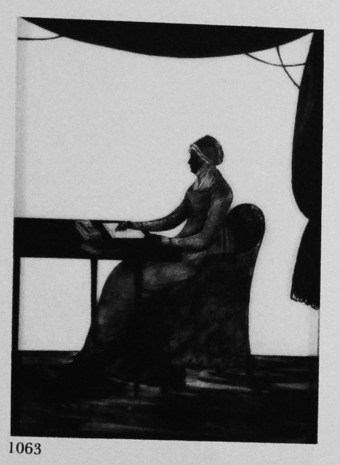
Mrs Holroyd
Silhouette painted on glass
August 1811
9 x 6in./229 x 153mm.
Trade Label No. 4
Frame: giltwood, with acanthus leaf and beading decoration
Inscribed on the reverse, ‘This belongs to Mrs. McWatts, the gift of Mrs Holroyd, August, 1811.’
Author’s collection
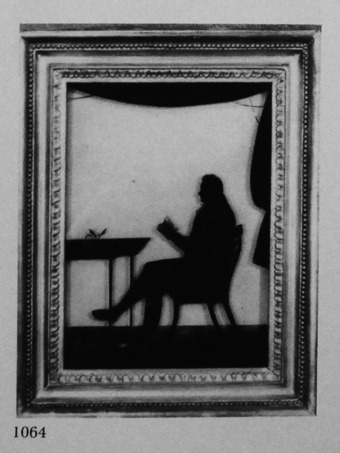
Unknown man reading a book
Silhouette painted on glass
c. 1811-13
9 x 6in./229 x 152 mm.
Trade Label No. 4
Frame: giltwood, with acanthus leaf and beading decoration
Since the sitter is shown reading a book on metastasis, he may have been a doctor. The setting is typical of hamlet’s full-length work.
Author’s collection
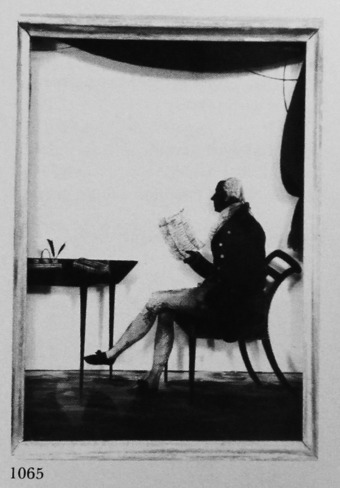
Unknown man reading a letter
Silhouette painted on glass
c. 1811-13
9 x 6½in./229 x 165 mm.
Trade Label No. 4
Frame: giltwood, with beading decoration
The letter which the sitter is reading bears an addredd at ‘Beverley, Yorks’ and begins ‘My Dear Brother’.
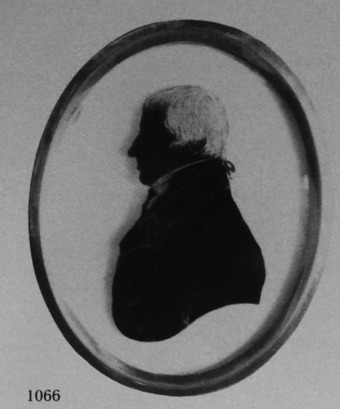
Sir William Addington
Silhouette painted on convex glass, backed with plaster
c. 1812
2½ x 2in./64 x 51mm.
Trade Label No. 4
Frame: papier mâché
By courtesy of R. Addington Ingle
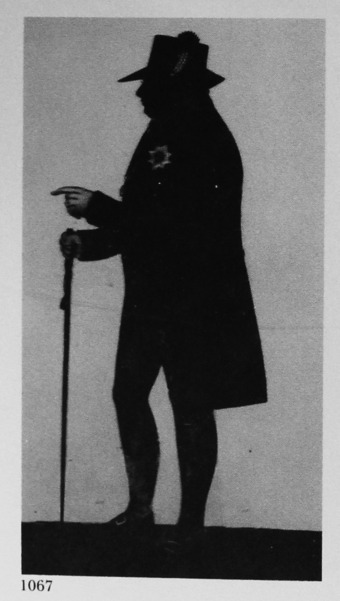
George III
Silhouette painted on glass
c. 1810
9 x 6in./229 x 153mm.
Trade Label No. 3
This silhouette may be a copy of a figure of the King in an earlier group silhouette, probably by Charles Rosenberg.
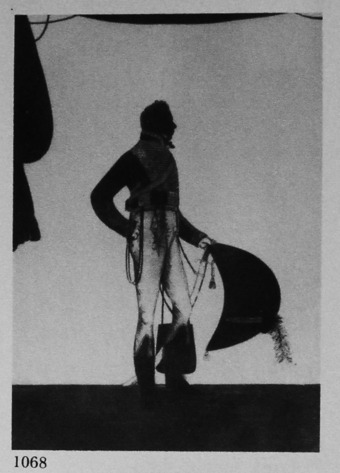
Captain Francis Swinfen, of the 16th Light Dragoons
Silhouette painted on glass, touched with gold
c. 1812
9 x 6in./229 x 153 mm.
Captain Swinfen fought at the Battle of Waterloo. As a cavalry officer, he wears his sash tied on the right.
From Weymer Mills, ‘One Hundred Silhouettes from the Wellesley collection’ (1912), by courtesy of the Oxford University Press
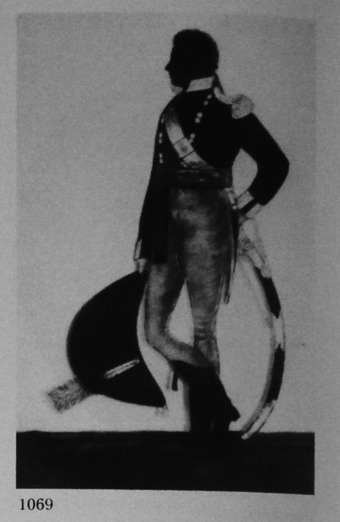
Captain Francis Holbourne
Silhouette painted on glass, touched with gold
c. 1812-13
9½ x 6¼in./242 x 159mm.
Trade Label No. 4
Frame: giltwood
Captain Holbourne, of Bath, was killed in action at Bayonne on 14 April 1814. He is buried at Bayonne in a cemetery where his sister many years later erected an obelisk to his memory. The obelisk bears an inscription, which describes him as ‘Captain Holbourne, Adjuant of the Third Guard Regiement, the eldest son of Sir Francis Holbourne, Bt.’ (see Charles Hargrove, ‘Bayonne’s English Cemetery, where Time has stood still since 1814’, Times, 10 May 1972).
Holborne of Menstrie Museum, Bath
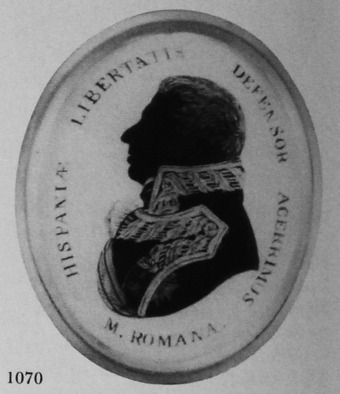
General the Marquis de la Romana
Silhouette painted on convex glass, touched with gold and backed with plaster, probably based on a stipple engraving by Cardon
c. 1810-11
2½ x 2in./64 x 51mm.
Trade Label No. 4
Frame: papier mâché
The general was commander of the Spanish army at the Battle of Corunna, 16 January 1809.
Author’s collection
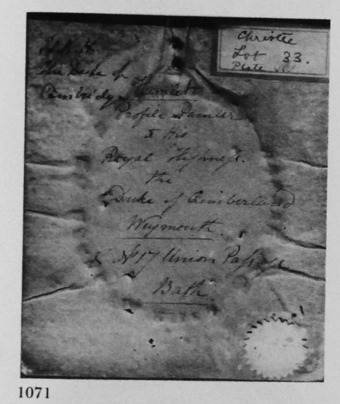
Trade Label No. 1e of William Hamlet the elder, from the silhouette shown in 1058.
By gracious permission of Her Majesty the Queen
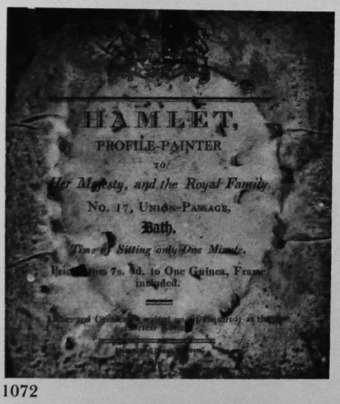
Trade Label No. 2 of William Hamlet the elder.
Author’s collection
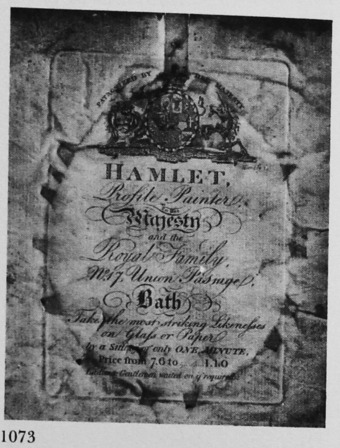
Trade Label No. 3 of William Hamlet the elder.
Author’s collection
DETAIL
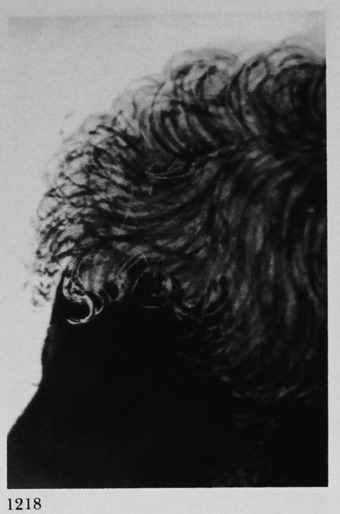
Man’s hair, near the face.
Detail from a silhouette, probably by William Hamlet the elder. Note the scratch line made by the needle, used to highlight the hair. (1061)
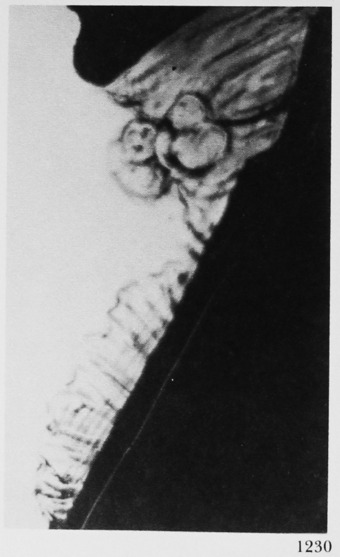
Shirt-frill
Detail from a silhouette of a man by William Hamlet the elder, showing the artist’s typical style of rendering a shirt-frill; he has used a needle to indicate the line of the lapel. (1061)
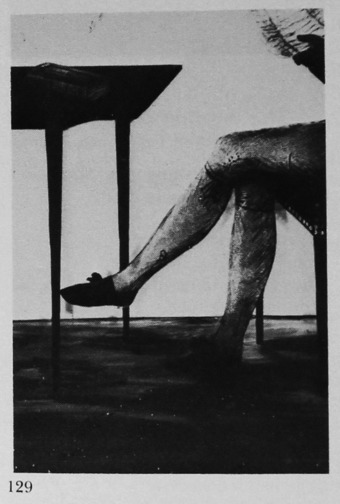
The legs o fan unknown seated man. Detail from a silhouette by William Hamlet the elder, 1811-12.
costume dating points
The breeches, fitting well down below the knee and fixed there both by buttons at the sides and by draw-strings.
The stockings with ‘clocks’, a fashion continuing from the previous decade.
The shoes with lachets, tied with strings, buckles having gone out of fashion by this date.
SECTION THREE
